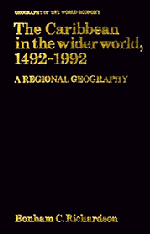Book contents
- Frontmatter
- Contents
- List of maps and tables
- Acknowledgements
- 1 The creation of the Caribbean
- 2 A colonized environment
- 3 Plantations and their peoples to 1900
- 4 The American century
- 5 Economic dependency
- 6 Human migrations
- 7 Resistance and political independence
- 8 Towards a geography of Caribbean nationhood
- Bibliography
- Index
1 - The creation of the Caribbean
Published online by Cambridge University Press: 10 November 2010
- Frontmatter
- Contents
- List of maps and tables
- Acknowledgements
- 1 The creation of the Caribbean
- 2 A colonized environment
- 3 Plantations and their peoples to 1900
- 4 The American century
- 5 Economic dependency
- 6 Human migrations
- 7 Resistance and political independence
- 8 Towards a geography of Caribbean nationhood
- Bibliography
- Index
Summary
The US Department of Commerce's 1989 guidebook, entitled Caribbean Basin Initiative, provides thumbnail sketches of commercial opportunities throughout the Caribbean for potential American investors. Haiti, the black republic occupying the western third of Hispaniola, is described therein as a particularly appealing locale: “Haiti's low wages, productive labor, strong private sector, and close proximity to the United States have been very attractive to offshore manufacturers, especially in electronics, apparel, toys, and sporting goods” (1988: 55).
The guidebook is not intended, of course, as an academic treatise, and it would be inappropriate to use it as a target. Yet its implications about Haiti (and very similar comments about other places in the circum-Caribbean region) are clear and important. Haiti's “low wages” and “productive labor” are portrayed as local cultural characteristics. And the happy combination of these indigenous Haitian characteristics with the “close proximity” of the world's largest national market suggests that it is not only economically rational but also helpful to all concerned that US manufacturers send component materials to these undemanding yet productive laborers for the fabrication of baseballs, playsuits, and TV parts for the North American market.
An historical-geographical assessment of Haiti provides a less exuberant but more instructive perspective. Aboriginal peoples called the entire island Quisqueya. It was “discovered,” claimed for Spain, and renamed Hispaniola by Christopher Columbus in 1492.
- Type
- Chapter
- Information
- The Caribbean in the Wider World, 1492–1992A Regional Geography, pp. 1 - 12Publisher: Cambridge University PressPrint publication year: 1992

